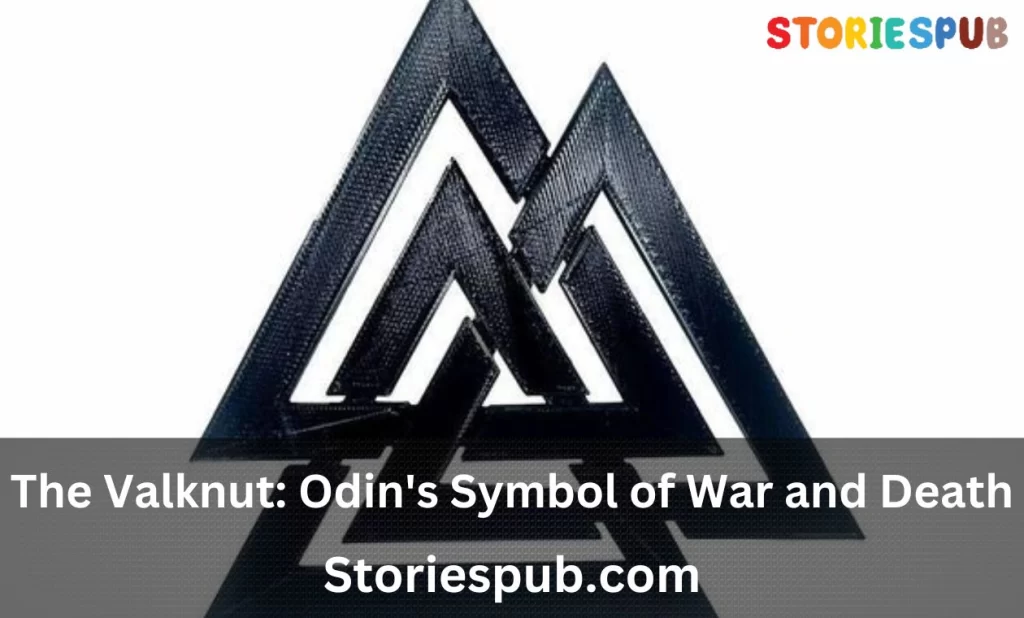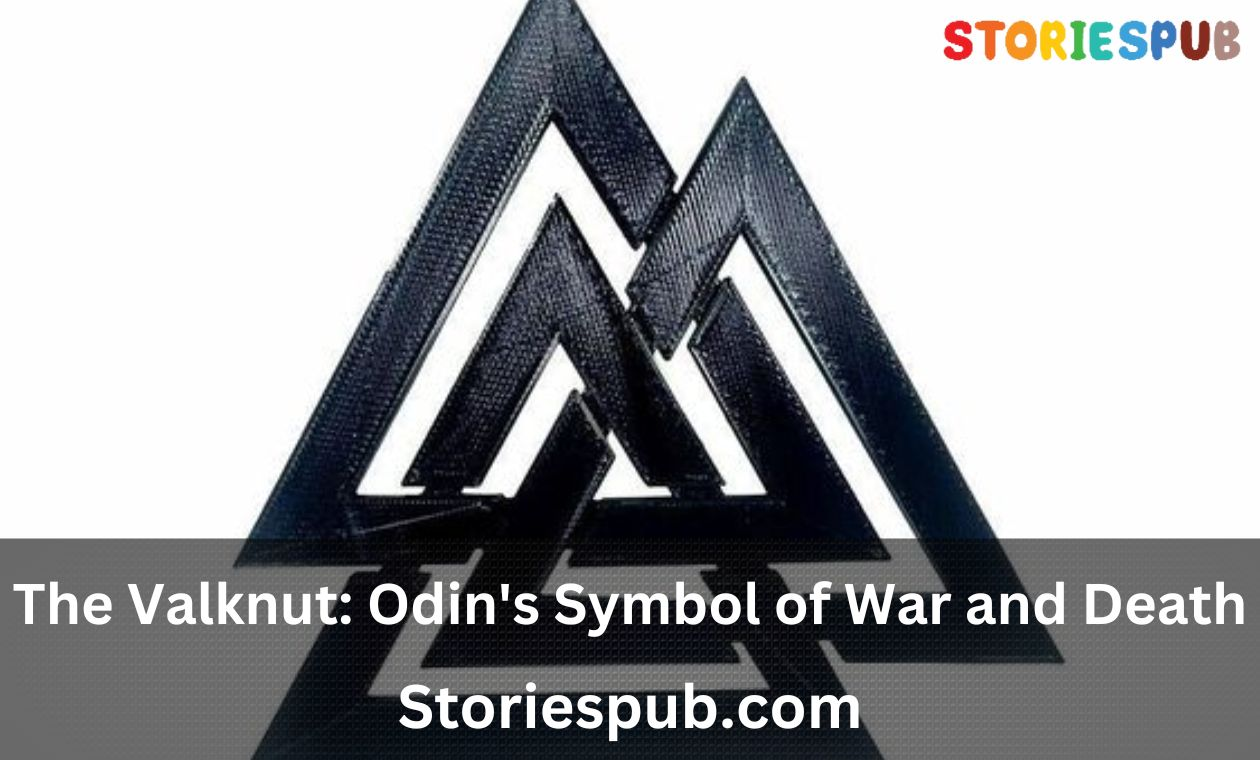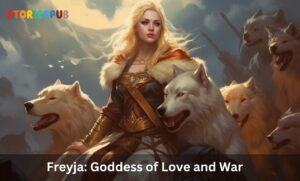The Valknut: Odin’s Symbol of War and Death

Introduction
Brief history of Norse mythology and Odin’s importance
The Norse mythology is a collection of stories and legends that originated from the Scandinavian region. These tales were based on the beliefs of ancient Germanic and Nordic people, who worshipped a pantheon of gods and goddesses. Among these deities, Odin stands out as one of the most important and revered.
Odin was considered the ruler of Asgard, one of nine worlds in Norse mythology. He was known as the god of wisdom, war, magic, poetry, and death.
According to legend, Odin was willing to sacrifice anything to gain knowledge and power. He was also associated with shamanism and had two animal companions; a pair of ravens named Huginn (thought) and Muninn (memory).
Explanation of Valknut symbol and its significance
The Valknut symbol is an ancient Viking symbol consisting of three interlocking triangles. It is also known as “the knot of the slain” or “Hrungnir’s heart” after an ancient giant killed by Thor in Norse mythology. The Valknut has been found inscribed on several runestones, standing stones carved with symbols used for commemorative or religious purposes.
The meaning behind this symbol has been debated by scholars for decades. Some suggest that it represents life cycles or rebirth since it is made up of three triangles interconnected in one continuous knot-like pattern without any beginning or end.
Others believe it symbolizes Odin’s power over life and death since he was the god who ruled over Valhalla, a hall where warriors slain in battle went after death. Regardless of its exact meaning or origin story, it remains clear that the Valknut held great significance for those who used it throughout history.
Its presence on runestones indicates that it may have been associated with commemoration or remembrance of the dead. However, its connection to Odin and his role in Norse mythology makes it likely that it was also a symbol of protection or strength.
The Legend of the Valknut
Odin’s quest for knowledge and power
In Norse mythology, Odin was the ruler of Asgard, one of the nine realms, and was considered the god of wisdom, war, and death. Odin was known to be a wise and powerful god who sought knowledge through various means such as sacrifice or exchanging an eye for wisdom.
According to legend, Odin hung himself from Yggdrasil (the world tree) for nine days and nights while wounded by his own spear to seek enlightenment. It is said that he gained knowledge of magic runes during this time.
Odin was also known to have many other magical objects in his possession such as his spear Gungnir which never misses its target. However, it is the Valknut symbol that holds a special place in Norse mythology.
Encounter with a wise woman who reveals the secret of the Valknut symbol
One day while traveling alone in Midgard (the realm of humans), Odin encountered a wise woman named Gunnlod who guarded a well containing mead made from Kvasir’s blood. She challenged him to answer her riddles in exchange for just three sips from the well. Odin accepted her challenge and successfully answered all her riddles.
In return, she allowed him three sips from the well which gave him immense wisdom. As a reward for his bravery and wit, Gunnlod revealed to him the secret of Valknut – The symbol consisting of three interlocking triangles representing Odin’s three aspects: warrior, wisdom seeker, and death bringer.
Odin’s use of the symbol in battle and as a sign of his authority
After gaining knowledge about Valknut from Gunnlod, Odin used it extensively during battles as it served as both an offensive and defensive weapon. It is said that upon seeing the Valknut symbol, the enemy warriors would become disoriented and unable to fight effectively. This gave Odin an edge in battles and helped him conquer more territories.
The Valknut was also used as a sign of his authority which displayed his connection to the gods and his status as king. It was sometimes inscribed on objects or carved into stones to mark territory or signify ownership.
Overall, the Valknut symbol played a crucial role in Norse mythology and its importance is still evident today. It remains a popular symbol in modern culture, often used as a tattoo or decorative item.
The Symbol’s Meaning
Interpretation of the Three Interlocking Triangles
The Valknut symbol is comprised of three interlocking triangles. Each triangle represents an aspect of Odin, the Allfather in Norse mythology. The first aspect is that of the warrior, which symbolizes Odin’s brave and aggressive nature when in battle.
The second aspect is that of the wisdom seeker, which represents Odin’s insatiable thirst for knowledge and desire to gain wisdom through experience. The third and final aspect is that of the death bringer, which emphasizes Odin’s role as a psychopomp or guide for souls who have passed into the afterlife.
Connection to Odin’s Three Aspects: Warrior, Wisdom Seeker, and Death Bringer
Odin was revered by Norse cultures as a figure who embodied many qualities, both positive and negative. As a god associated with war and death, he was often depicted as a fierce warrior or heroic leader who led armies into battle. However, he was also considered to be a wise sage who traveled extensively in search of knowledge and insight into the workings of the world.
The Valknut symbol serves as a reminder of these three aspects that are so central to Odin’s mythology. It suggests that while he was indeed a god of war and destruction on one hand, he was also deeply committed to understanding life’s mysteries on another.
Symbolic Representation of Past, Present, and Future
In addition to its connection with Odin’s tripartite nature, some interpretations suggest that the Valknut symbol also represents past, present, and future timelines. This idea can be further extended by considering each triangle as an interpretation for each time period. The first triangle might represent the past – everything leading up to now – while the second could represent present circumstances; what is happening around us right now; and the third triangle represents the future – what is yet to come.
Significance in Norse Culture as a Symbol of Protection
Another interpretation of Valknut’s symbolism associates it with protection. In Norse mythology, Odin was considered to be a god who protected his followers in battle and guided them safely through dark times. Some people believe that the Valknut symbol was used by ancient warriors as a protective amulet, much like how some people use charms or talismans today.
This interpretation also suggests that the interlocking nature of each triangle is symbolic of Odin’s ability to protect his followers from all sides, and from every angle. The three interlocking triangles are thought to represent Odin’s power to protect his subjects in mind, body, and spirit.
The meaning behind Valknut symbol goes far beyond its simple appearance. It is a powerful and complex representation of one of Norse mythology’s most revered gods – Odin.
Its tripartite structure reflects his three aspects while also serving as a reminder of the past, present, and future timelines. It is an emblem of strength and protection that has been carried forward into modern times where it continues to hold significance for many people around the world today.
The Legacy of the Valknut
Use in Modern Culture as a Tattoo or Decorative Item
The Valknut symbol has become increasingly popular in modern culture, particularly as a tattoo design. Many people are drawn to the unique and intricate design of the three interlocking triangles, and use it as a way to express their love for Norse mythology and their admiration for Odin.
The symbol is often depicted in black ink, but can also be seen in various colors, styles, and sizes. Aside from tattoos, the Valknut symbol is also used as a decorative item.
It can be found on clothing, jewelry pieces such as pendants or rings, home decor items like wall art or tapestries, and even on car decals. Its versatility makes it a popular choice for any form of self-expression.
Controversy Surrounding its Association with White Supremacy Groups
Unfortunately, some individuals have co-opted the use of the Valknut symbol for malicious purposes. In recent years, it has been associated with white supremacy groups who have misused its meaning to promote hate and bigotry. This misuse has led to significant controversy surrounding its use and has made many people hesitant to display it publicly.
It’s important to note that this association is not representative of the true meaning behind the symbol nor its widespread use by those who simply appreciate Norse mythology. The Valknut represents Odin’s connection with death and his role as a warrior; it is in no way related to white supremacist ideologies.
To combat this negative association, many organizations dedicated to promoting Nordic culture have taken steps towards reclaiming the true meaning behind the Valknut symbol. They have endeavored to increase awareness about its origins and significance while condemning any attempts at using it for hateful purposes.
Preservation Efforts by Nordic Cultural Organizations
Nordic cultural organizations have recognized the importance of preserving the history and significance of the Valknut symbol. Many of these groups have made efforts to educate individuals about its meaning, origins, and cultural significance.
These organizations have also taken steps towards reclaiming the symbol back from those who have misused it for nefarious purposes. They have promoted its use in a positive light and encouraged people to openly display it as a symbol of Nordic heritage.
Additionally, many institutions have dedicated resources to studying Norse mythology and culture in order to preserve its history for future generations. Through these efforts, we can continue to appreciate and celebrate the true meaning behind the Valknut symbol.
Conclusion
The Valknut symbol is a powerful representation of Odin’s connection with death, wisdom, and battle. Its intricate design has captivated people throughout history and continues to be beloved by many today. While there may be controversy surrounding its misuse by white supremacist groups, it’s important to remember that this association is not representative of its true meaning or widespread use.
Nordic cultural organizations are working hard towards reclaiming the symbol back from those who have tarnished it while continuing to promote awareness about its significance. Ultimately, the legacy of the Valknut will continue on through our appreciation for Norse mythology and our dedication towards preserving its history for future generations.
Conclusion
A Recap on the Importance and meaning behind Valknut
The Valknut symbol, also known as Odin’s knot or the knot of the slain, has a rich history and profound meaning in Norse mythology. It is a visual representation of Odin’s power, wisdom, and authority, as well as his connection to protection and the afterlife. The three interlocking triangles signify Odin’s three aspects: warrior, wisdom seeker, and death bringer.
Through countless battles and conquests, Odin used this powerful symbol to instill fear in his enemies and to signify his authority over all things. In modern times, it has taken on new meanings for many people around the world.
Some see it as a representation of their own personal strength or protection against evil forces. However, its association with white supremacy groups has caused controversy and led to its misuse in recent years.
It is essential to note that these groups have co-opted the symbol for their own purposes; it does not reflect the true meaning or intention behind Valknut. Efforts are being made by Nordic cultural organizations to preserve this symbol’s authentic meaning while educating others about its profound cultural significance.
By understanding the history behind this ancient symbol, we can gain insight into Norse mythology as well as connect with our roots. Valknut may be an ancient symbol from Norse mythology but it still carries significant symbolism today.
Its use shows no signs of stopping anytime soon; regardless of what happens in society at large – people will continue finding meaning through Valknut symbolism because it speaks to our human need for spiritual connection with something greater than ourselves. The enduring legacy of this mythological figure reminds us all that even amidst chaos there is always hope when we connect with our roots and understand our rich history – so embrace your inner warrior today!
Hey kids, how much did you like The The Valknut: Odin’s Symbol of War and Death? Please share your view in the comment box. Also, please share this story with your friends on social media so they can also enjoy it, and for more such Norse Mythology, , please bookmark storiespub.com.
Related Post :
Valknut FAQ
What does the Valknut symbolize?
The meaning of the Valknut is not clear, but it is often associated with the afterlife, as well as with Odin's ability to choose who will live and who will die in battle.
Where has the Valknut been found?
The Valknut has been found on several artifacts from Viking Age Scandinavia, including on runestones, on jewelry, and on the Oseberg ship burial.
Is the Valknut only associated with Odin?
While the Valknut is primarily associated with Odin, it has also been found on artifacts associated with other Norse gods, such as Thor and Freyja.
Is the Valknut a religious symbol?
The Valknut is not a religious symbol in the traditional sense, but it has been associated with Norse mythology and the Viking Age culture.
How is the Valknut used today?
The Valknut has been adopted by some modern-day practitioners of Germanic paganism as a symbol of their faith, and it is also used by some neo-Nazis as a symbol of white supremacy.
Why is the Valknut associated with death?
The Valknut's association with death is likely due to its use in funerary contexts and its association with Odin, who was believed to choose who would die in battle.
Is the Valknut similar to other symbols?
The Valknut is similar in appearance to other symbols found in other cultures, such as the Borromean rings in Christian art and the triskelion in Celtic art.
What is the significance of the three interlocking triangles?
The significance of the three interlocking triangles is not entirely clear, but some theories suggest that they represent the three levels of existence: the physical, mental, and spiritual realms.
Is the Valknut still important today?
While the Valknut may not have the same significance it once did, it remains an important symbol in Norse mythology and is still studied and appreciated by scholars and enthusiasts alike.




